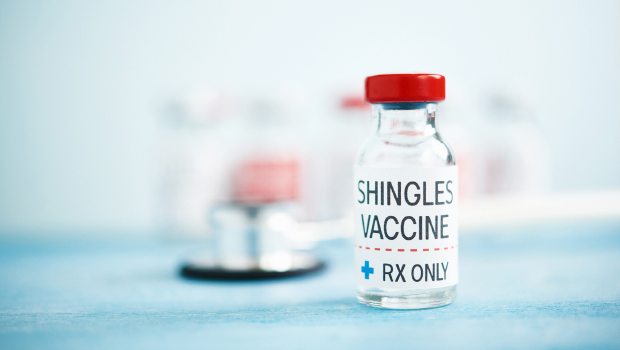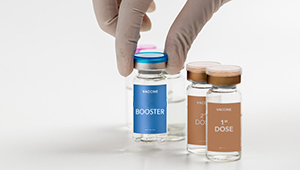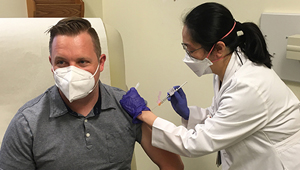New study confirms safety of shingles vaccine

KPWHRI researchers analyzed data from more than 640,000 vaccine doses to understand risk of severe reactions
Newly published results support previous findings that the recombinant zoster vaccine Shingrix, recommended by the CDC (Centers for Disease Control and Prevention) for preventing shingles and its complications, is safe and unlikely to cause a serious reaction in healthy adults. The study, led by Kaiser Permanente Washington Health Research Institute (KPWHRI) Senior Investigator Jen Nelson, PhD, with Senior Investigator Lisa Jackson, MD, MPH, was published in the American Journal of Epidemiology.
The findings bolster safety data from efficacy trials done before the vaccine was licensed and unsolicited reports from clinicians or people who received a vaccination shortly after the vaccine was rolled out in 2018.
"It’s important to study vaccine safety in the period after a vaccine is released and is being administered widely throughout the population, and doing these types of studies soon after a vaccine is licensed has been a priority for the CDC for a long time,” Nelson said. “By paying attention during this early rollout period, we can confirm that what we're seeing lines up with the early safety data and understand if there’s anything happening that the clinical trials weren’t able to detect."
Other KPWHRI co-authors on the study were Onchee Yu, MS, Andrea Cook, PhD, Rachael Burganowski, MS, and Erika Kiniry, MPH.
Researchers used electronic health record data from sites in the Vaccine Safety Datalink (VSD), a collaborative project between the CDC and 9 health care organizations that have capacity to conduct vaccine safety studies in large populations. Sites in the VSD first began to use the Shingrix vaccine in January 2018. The study monitored vaccine doses given to adults over age 50 at 7 VSD sites through December 2019 — a total of 647,833 doses — to better understand risk of adverse outcomes.
"The VSD has the advantage of a well-established data infrastructure, and it includes a large, geographically diverse population," Nelson said. "The sites’ study teams also include clinicians working in the different health systems, which means we could quickly review charts to follow up on preliminary findings and validate what we were seeing in the electronic health care data.”
Researchers used electronic health record data to calculate relative risk of 10 different primary outcomes and 11 secondary outcomes. They compared the Shingrix group to 2 different comparison groups: people who did not receive the Shingrix vaccine who had a well care visit at the VSD sites during the study period and people who had received the earlier shingles vaccine, Zostavax.
The primary outcomes were chosen based on observations from the pre-licensure clinical trials of the vaccine and from known possible outcomes traditionally followed during vaccine safety studies, such as allergic reactions. The list of primary outcomes included stroke, convulsions, severe allergic reactions (anaphylaxis), irregular heartbeat, and Guillain-Barre syndrome, a rare disorder where the body's immune system attacks the nerves.
Secondary outcomes included local reactions such as pain or swelling at the injection site, systemic reactions like fever or muscle pain, gout, and inflammation of the heart muscle or lining.
“The primary outcomes are serious or rare events that weren’t able to be studied thoroughly in previous trials,” Nelson explained. “Understanding the risk of serious adverse outcomes was our primary focus. We also looked at secondary outcomes both to see if our data matched up with what was seen in the earlier trials and to explore a broader set of potential adverse events.”
The researchers found that there was no sustained increased risk for any of the primary outcomes relative to the 2 other study groups, meaning that people receiving the Shingrix vaccine were no more likely to have any of those 10 outcomes than people who received the earlier vaccine or those who did not receive a vaccine.
They confirmed results from the earlier safety studies showing that there is an increased risk for local or systemic reactions within 1 to 7 days after vaccination. Most reactions were not severe, and there was no evidence that the vaccine was unsafe.
One major challenge in vaccine safety studies of older adults is adjusting for underlying health differences in the study group that gets a vaccine and those who don’t. People who get a vaccine are often more likely to engage in other healthy behaviors, like having a good diet and doing regular exercise, which make them healthier overall. It’s important to account for these differences in order to be sure that differences in adverse event risks seen in the study are the result of the vaccine and not other reasons. The researchers used a new method in this study that involved summarizing many factors into a single score to better account for inherent differences in health and healthy behaviors in their risk estimates.
The researchers recommended that future studies look at non-acute events on a longer timeline, up to a year after vaccination. They plan to publish another study that examines the impact of healthy user bias on some of the associations they observed during this research. For example, the results showed that recipients of the Shingrix vaccine had a lower risk of getting pneumonia than the group that did not receive a vaccine. However, this could be due to the fact that people seeking out the vaccine were healthier overall.
“We’re not ready to say that the vaccine protects people against pneumonia,” Nelson said. “It’s a known consideration in studies of older adults that people who choose to get vaccinated are often healthier than those who don’t get vaccinated, so we need to look more closely at the apparent protective effect we saw in our study before coming to a conclusion.”
What is shingles, and who needs a vaccine?
Shingles (herpes zoster) is caused by the varicella zoster virus, the same virus that causes chickenpox. In people who have had chickenpox, the virus stays in their body and can reactivate as shingles, usually in response to stress or a weakened immune system. Shingles commonly appears as a painful rash on one side of the body, sometimes on the face, that can last for several weeks.
The CDC recommends the Shingrix vaccine for adults over 50 and for adults 19 years and older with weakened immune systems. In healthy adults, the vaccine is more than 90% effective at preventing shingles, and immunity lasts for at least 7 years. Even if someone has already had shingles, the vaccine can prevent a recurrence of the disease. Zostavax, a live-attenuated shingles vaccine that was licensed in 2006, was much less effective than the new vaccine and is no longer used.
Co-researcher
Lisa A. Jackson, MD, MPH
Senior Investigator
Kaiser Permanente Washington Health Research Institute
Vaccine Safety

Biostatisticians track COVID-19 vaccine safety
Dr. Jennifer Nelson explains how KP scientists are helping the CDC and FDA keep an eye out for rare adverse events.
COVID-19

Updated results from COVID-19 vaccine booster trial
IDCRC study finds rapid decline in vaccine-boosted neutralizing antibodies against Omicron variant BA.5
Research

Researchers begin clinical trial to assess schistosomiasis vaccine
Participant in KPWHRI trial has first-ever injection of SchistoShield vaccination.



